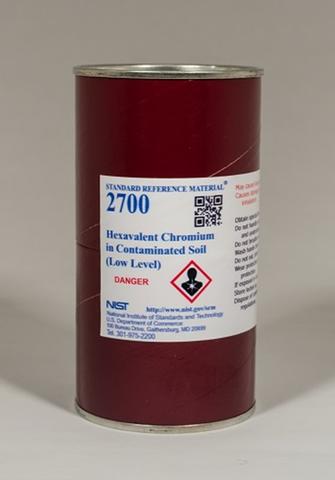Summary
Significant environmental remediation efforts are being conducted to address the hazards posed by the long-term terrestrial disposal of hexavalent chromium in the form of chromite ore processing waste. These efforts are being driven by the intended economic re-development of some of these waste sites, and to reduce the environmental impact and associated risk to human health. Two new chromium-contaminated soil SRMs are being developed to provide quality assurance for these remediation activities.
Description

SRM 2700 Hexavalent Chromium in Contaminated Soil (Low Level)
During the last century, chromate and dichromate chemical production facilities processed considerable amounts of chromite ore for industrial manufacturing purposes. The waste material from these operations called chromite ore processing residue (COPR) was disposed of in waste sites across the United States, and also used as fill material for building foundations, road construction, and other civil engineering applications such as filling of wetlands. The material has been found in residential, commercial, industrial, and recreational areas. In New Jersey alone, over two million tons of waste was discarded, and 160 waste sites have now been identified that were contaminated with COPR. This waste material consists of a mixture of chromite (CrIII) and chromate (CrVI), otherwise known as hexavalent chromium, which is now widely recognized as a human carcinogen. Based on its relatively high solubility in aqueous systems, hexavalent chromium is fairly mobile and therefore the potential environmental and human impact is of great concern. For effective site remediation and waste management activities, there is a need to make analytical measurements of known quality. There is an critical need for a high-quality reference material to provide quality assurance for such measurements.
Major Accomplishments
-
Development of a new speciated environmental material, SRM 2701 Hexavalent Chromium in Contaminated Soil, High Level, and SRM 2700 Hexavalent Chromium in Contaminated Soil, Low Level have been completed.
-
Analytical method development using species-specific isotope dilution ICP-MS for the accurate determination of hexavalent chromium, has been completed.
Additional Technical Details
In partnership with the New Jersey Department of Environmental Protection (NJDEP), SRM 2701 has been certified to provide quality assurance support for environmental remediation measurements. The material for SRM 2701 Hexavalent Chromium in Contaminated Soil was collected from a waste site in Hudson County, New Jersey, and then certified for hexavalent chromium by speciated isotope dilution mass spectrometry (SIDMS), and for total chromium by wavelength dispersive X-Ray fluorescence spectrometry (WDXRF), isotope dilution inductively coupled plasma mass spectrometry (ID-ICP-MS), and instrumental neutron activation analysis (INAA). The material has also been certified for iron by WDXRF, INAA, and thermal neutron prompt gamma-ray activation analysis (PGAA), and for manganese by WDXRF and INAA. Reference values are also provided for additional elements including aluminum, calcium, magnesium, nickel, silicon, sulfur, titanium, and vanadium. The certified concentration of hexavalent chromium in the material is relatively high (550 mg/kg), and therefore, a companion material (SRM 2700), which will consist of SRM 2701 diluted with quartz sand, is under development in a collaborative project with the U.S. Geological Survey (USGS) and the NJDEP. The companion material will have a hexavalent chromium concentration approximately twenty times lower than SRM 2701 and is intended to provide additional choice for customers having different measurement requirements. The use of quartz (which is inert) as the diluent is intended to maintain the stability of the chromium oxidation states in the material.
Associated Products
SRM 2701 Hexavalent Chromium in Contaminated Soil (High Level) - values assigned for hexavalent chromium, total chromium, manganese, and iron
Associated Publications
-
Jahrman, E. P., Seidler, G. T., and Sieber, J. R., "Determination of Hexavalent Chromium Fractions in Plastics Using Laboratory-Based, High-Resolution X-ray Emission Spectroscopy," Analytical Chemistry, 90, 6587-6593 (2018).
-
Malherbe, J., Isaure, M. P., Seby, F., Watson, R. P., Rodriguez-Gonzalez, P., Stutzman, P. E., Davis, C. W., Maurizio, C., Unceta, N., Sieber, J. R., Long, S. E., and Donard, O. F. X., "Evaluation of Hexavalent Chromium Extraction Method EPA Method 3060A for Soils Using XANES Spectroscopy," Environ. Sci. Technol., 45, 10492-10500 (2011).
-
Nagourney, S.J., Wilson, S.A., Buckley, B., Kingston, H.M., Yang S.Y., and Long, S.E., Development of a Standard Reference Material for Cr(VI) in Contaminated Soil, J. Anal. Atom. Spectrom, 23:1550-1554 (2008).

